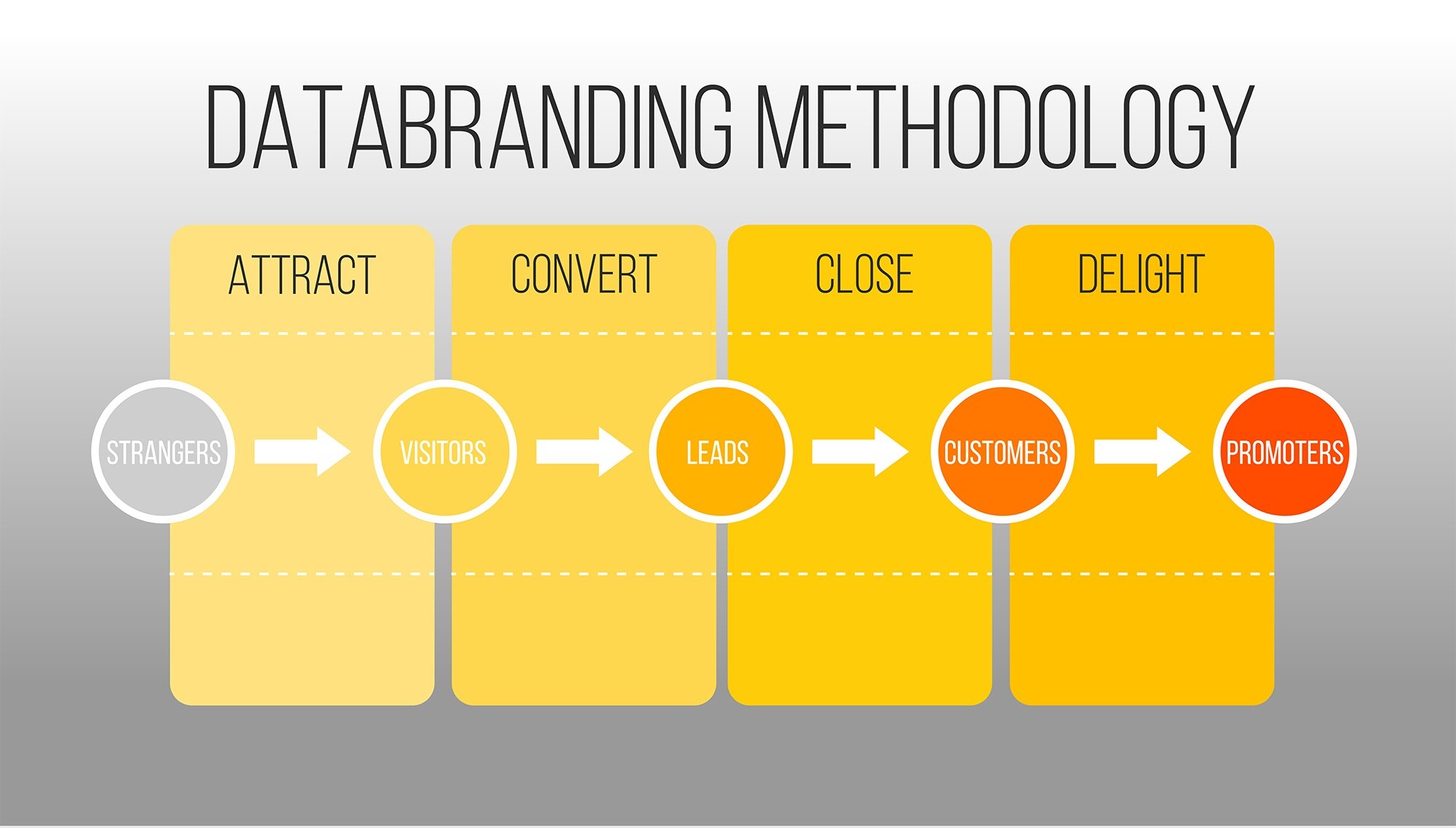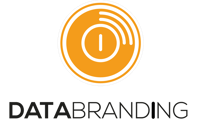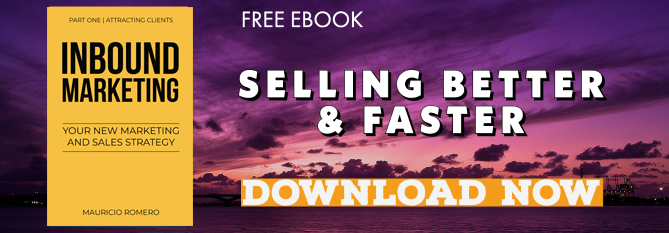Inbound Marketing is "in" because it is one of the most complete marketing methodologies that brings together all the disciplines of digital marketing and makes them work together under a same strategy, with proven sales and positioning results in more than 11 thousand companies throughout the planet.
After helping dozens of clients to implement this strategy, we realized that putting all the pieces together when starting to apply this strategy, is not so easy. So we are starting by explaining the basics of the strategy.

Inbound Marketing Methodology
The following steps are taken in this methodology:
1.- Attract strangers with inbound marketing
The first step is to attract Internet users to our website by means of the content that they are looking for, based on their interests. What people are usually looking for, is to solve a problem they have or look for an opportunity, which is why they start their research process and therefore, their decision process about a solution.
This research that the user makes based on a topic, begins in a search engine, such as Google. A person asks something, and Google (or any other search engine) offers several recommendations to this person.
Google recommends that content which might help this person solve his doubts and learn more about the subject. What we are really doing here, is educating our client with information that tries to solve all of his doubts. How much does this strategy cost? What problems might I face when using it? How does it work compared to other solutions? Does it really solve my problem? Which is the best option? etc.
This step is very important since an educated client better recognizes the value of the solution given and thus, is willing to pay more for it.
These contents can be offered under different formats, such as audio, video or a written article. They can be located in different areas, like on your website or inside a blog, and they can also be shared in social networks. These contents can also be used with a social networking strategy in order to bring more visitors to our site.
This is where a content strategy in needed and it'll achieve 2 things. The first one is that Google will recommend our content without having to pay for it, and the second one is that these contents will help the client move forward in his buying decision process.
Now, traffic or the number of visitors that come to your website, don't generate an income per se, yet potential clients do.
2.- Convert visitors into leads with Inbound Marketing
The second part is to convert the traffic that arrives to your site into leads. Visitors who just take a look at our content stay anonymous. This does not help our strategy at all, since there is no way to start a conversation with them, we have no way to contact them.
When I say "convert" our visitors, I mean get their contact information. If our visitors don't voluntarily share with us their information, all of our content strategy/effort will be lost. What we want, is to send them more information related to their interests and context. This is what we call to nourish the prospect in Inbound Marketing. We want to educate them until they are ready to buy, but in a very subtle way, without being too invasive and at the customer's own pace.
How to turn visitors into leads?
We want to get to know every visitor that comes to our site: their tastes, preferences and interests. We share premium content with our visitors in exchange for their contact information, which they will be sharing voluntarily with us. We make an information exchange (Otherwise, they won't have access to this premium content).
The right way to do this, is by offering our visitor interesting premium content in exchange for their email and name. This premium content should give them a much more complete view of how you can help them solve their problem or how to find the opportunity they are looking for. The aim of this content is to help them solve what's on their mind.
This is a very useful technique since, what the person wants is to learn how he can solve his problem or solve his need by means of self-education. At this point, his intention is not to buy something right away but to learn about the options that he has.
There is a difference between sharing educational material and giving free advice. You should not worry about this, you should only give your customer enough information so that:
- He can make a decision
- He gets interested enough
- He goes for the solution that your company offers
3.- Close leads and turn them into clients/customers with Inbound Marketing
Based on the prospects database that we will create with the information that they share with us, we should start to nurturing them with more content, more information, in other words, we should educate and guide them during their purchase process. There are subsequent conversions during this process at which prospects asks for more support and contents and are willing to share more information about their tastes and preferences in return.
This process helps us to segment and qualify our prospects in order to customize the information that comes and goes. We always say that a sale should be based on the client's problem and not on the skills and competences of the seller. We should be able to show them that we are interested in solving their problem and not on selling.
Much of this methodology can be done in an automated using workflows (automated mails that are triggered by a visitor's action) which notify the sales teams which clients should they communicate with -in the short and medium term- by means of the integration of a CRM (Customer Relationship Management) software. With this process, we generate real sales opportunities and make sales teams more efficient.
A very important part of this step is what we do with INBOUND SALES, which has its own specific methodology.
4.- Delight clients with Inbound Marketing
Finally, retaining current customers might be even more important than getting new ones. We can achieve this by delighting our customers with more content, turning them thus, into promoters. This allows us to have an open communication channel with our client until the need for our product or service arises again.
We do this with materials that are published on social networks, email campaigns, specific workflows and intelligent calls-to-action that allow us to provide a higher quality experience to our audience. We can personalize our same website (or parts of it) according to our customers; whether they are first-time visitors, prospects or customers.
Analyzing Data with Inbound Marketing
Analyzing data is not included in the methodology image that we shared above as a separate part because it is actually present on each and every part and process of the Inbound Marketing methodology, which makes this methodology a measurable and improvable one, at all times.
Each of these Inbound Marketing steps involve a series of additional techniques such as SEO, Landing Pages, automated email marketing, nurturing campaigns and lead management, making it the perfect tool to use along with a strategy that includes all the digital marketing elements.
How to Learn Inbound Marketing
Learning to do Inbound Marketing requires great effort and time from the marketing and sales teams. As we mentioned at the beginning of this article, knowing all about these disciplines becomes overwhelming at the start. There are several challenges that an organization has to face in order to achieve a successful strategy and implementation, such as training, working culture change, technological resources, and practice.
Do you want to learn more about Inbound Marketing? We have several useful resources you might be interested in:
- Inbound Marketing and Sales Best Practices workshops, trainings and conferences. Although we know that there are many online courses that help you learn more about this tool, creating a successful strategy is a whole different thing. Which is why we've designed this courses and workshops at which we share the experiences that we've had and learned from. This help you shorten the time spent on the learning curve and on achieving success.
- Our Inbound Marketing and Sales Blog
- Our free Inbound Marketing Ebook, downloadable here:

